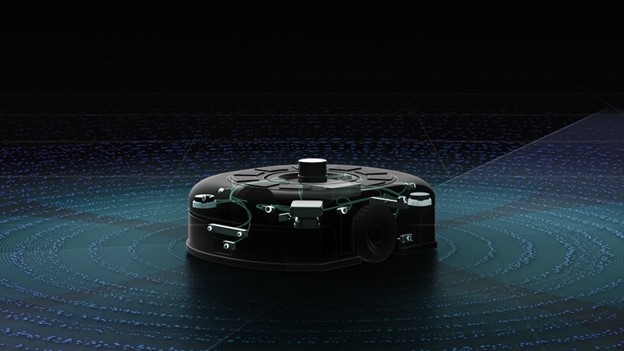Next-day packages. New vehicle deliveries. Fresh organic produce. Each of these modern conveniences is accelerated by fleets of mobile robots.
NVIDIA today is announcing updates to Nova Orin — an autonomous mobile robot (AMR) reference platform — that advance its roadmap. We’re releasing details of three reference platform configurations. Two use a single Jetson AGX Orin — which runs the NVIDIA Isaac robotics stack and the Robot Operating System (ROS) with the GPU-accelerated framework — and one relies on two Orin modules.
The Nova Orin platform is designed to improve reliability and reduce development costs worldwide for building and deploying AMRs.
AMRs are like self-driving cars but for unstructured environments. They don’t need fixed, preprogrammed tracks and are capable of avoiding obstacles. This makes them ideal in logistics for moving items in warehouses, distribution centers and factories, or for applications in hospitality, cleaning, roaming security and last-mile delivery.
For years, AMR manufacturers have been designing robots by sourcing and integrating compute hardware, software and sensors in house. This time-consuming effort demands years of engineering resources, lengthens go-to-market pipelines and distracts from developing domain-specific applications.
Nova Orin offers a better way forward with tested, industrial-grade configurations of sensors, software and GPU-computing capabilities. Tapping into the NVIDIA AI platform frees developers to focus on building their unique software stack of robot applications.
Much is at stake for intralogistics enabled by AMRs across industries, a market expected to increase nearly 6x to $46 billion by 2030, up from $8 billion in 2021, according to estimates from ABI Research.
Designing a Highly Capable, Flexible Reference Architecture
The Nova Orin reference architecture designs are provided for specific use cases. There is one Orin-based design without safety-certified sensors, and one that includes them, along with a safety programmable logic controller. The third architecture has a dual Orin-based design that depends on vision AI for enabling functional safety.
Sensor support is included for stereo cameras, lidars, ultrasonic sensors and inertial measurement units. The chosen sensors have been selected to balance performance, price and reliability for industrial applications. The suite of sensors provides a multimodal diversity of coverage that is required for developing and deploying safe and collaborative AMRs.
The stereo cameras and fisheye cameras are custom designed by NVIDIA in coordination with camera partners. All sensors are calibrated and time synchronized, and come with drivers for reliable data capture. These sensors allow AMRs to detect objects and obstacles across a wide range of situations while also enabling simultaneous localization and mapping (SLAM).
NVIDIA provides two lidar options, one for applications that don’t need sensors certified for functional safety, and the other for those that do. In addition to these 2D lidars, Nova Orin supports 3D lidar for mapping and ground-truth data collection.
Building a Comprehensive AI Platform for OEMs, ISVs
NVIDIA is driving the Nova Orin platform forward with extensive software support in addition to the hardware and integration tools.
The base OS includes drivers and firmware for all the hardware and adaptation tools, as well as design guides for integrating it with robots. Nova can be integrated easily with a ROS-based robot application.
The sensors will have validated models in Isaac Sim for application development and testing without the need for an actual robot.
The cloud-native data acquisition tools eliminate the arduous task of setting up data pipelines for the vast amount of sensor data needed for training models, debugging and analytics. State-of-the-art GEMs developed for Nova sensors are GPU accelerated with the Jetson Orin platform, providing key building blocks such as visual SLAM, stereo depth estimation, obstacle detection, 3D reconstruction, semantic segmentation and pose estimation.
Nova Orin also addresses the need to quickly create high-fidelity, city-scale 3D maps for indoor environments in the cloud. These generated maps allow robot navigation, fleet planning and simulation. Plus, the maps can be continuously updated using data from the robots.
AMRs That Are Ready for Industries
As robotics systems evolve, the need for secure deployment and management of the critical AI software on board is paramount for future AMRs.
Nova Orin supports secure over-the-air updates, as well as device management and monitoring, to enable easy deployment and reduce the cost of maintenance. Its open, modular design enables developers to use some or all capabilities of the platform and extend it to quickly develop robotics applications.
NVIDIA is working closely with regulatory bodies to develop vision-enabled safety technology to further reduce the cost and improve reliability of AMRs. And we’re providing a software development kit for navigation, so developers can quickly develop applications.
Improving productivity for factories and warehouses will depend on AMRs working safely and efficiently side by side at scale. High levels of autonomy driven by 3D perception from Nova Orin will help drive that revolution.
Learn more about Nova Orin and sign up to be notified of its availability.
